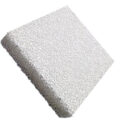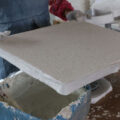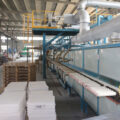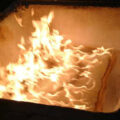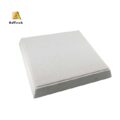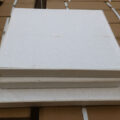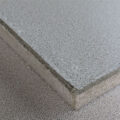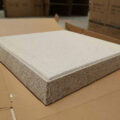The filter plate has an open-pored structure, which is characterized by having a plurality of interconnected voids, so that molten metal can pass through to remove entrained solids. Such filters include solid filter plates made of sintered ceramic aggregate.
A ceramic foam filter with an open-cell structure, which is characterized by a plurality of interconnected voids surrounded by the ceramic material net. The air permeability of the ceramic filter is 400 to 8000×10-7 cm2, preferably 400 to 2500×10-7 cm2, the porosity or porosity is 0.80 to 0.95, and 5 to 45 pores per linear inch, preferably per linear inch 20 to 45 holes. The flow rate of molten metal through the filter is 5 to 50 cubic inches per minute per square inch of filter area. Because it is cheap and can be used once. In addition, the molten metal ceramic foam filter plate achieves unexpectedly effective filtering of molten metal, especially aluminum, at low cost, and achieves unexpected filtering efficiency with amazing flexibility. The permeability and pore size of each filter type medium can be changed to suit the specific material being filtered.
The ceramic foam filter is made of an open-cell flexible foam material having a plurality of interconnected voids surrounded by a net of the flexible foam material, such as polyurethane foam or cellulose foam.
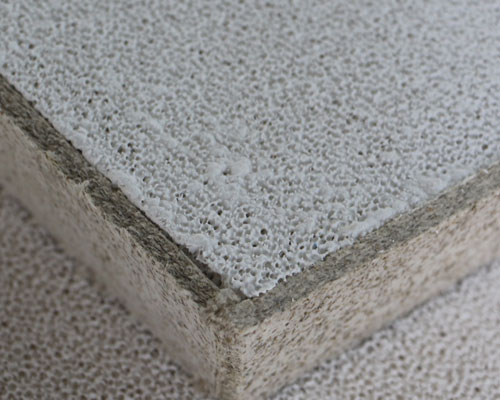
Ceramic foam filter manufacturing process: preparing water-based ceramic slurry, impregnating the foam material with foam ceramic material, thereby coating the mesh surface and filling the voids. The impregnated material is compressed so that a part of the slurry is discharged from here and the rest is evenly distributed throughout the foam material. The coated foam material is then dried and heated to first burn off the flexible organic foam, and then sinter the ceramic coating, thereby providing a molten ceramic foam having a plurality of interconnected voids that are bonded or molten ceramic It is surrounded by a net and has a soft foam shape. Naturally, depending on the specific metal to be filtered, a variety of ceramic materials can be selected. Preferably, a mixture of aluminum oxide and chromium oxide is used. However, these materials can be used alone or in combination with other ceramic materials. Other typical ceramic materials that can be used include zirconia, magnesia, titanium dioxide, silicon dioxide and mixtures thereof. Typically, the slurry contains about 10 to 40% water and one or more rheological agents, binders or air setting agents.

